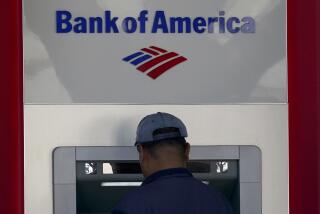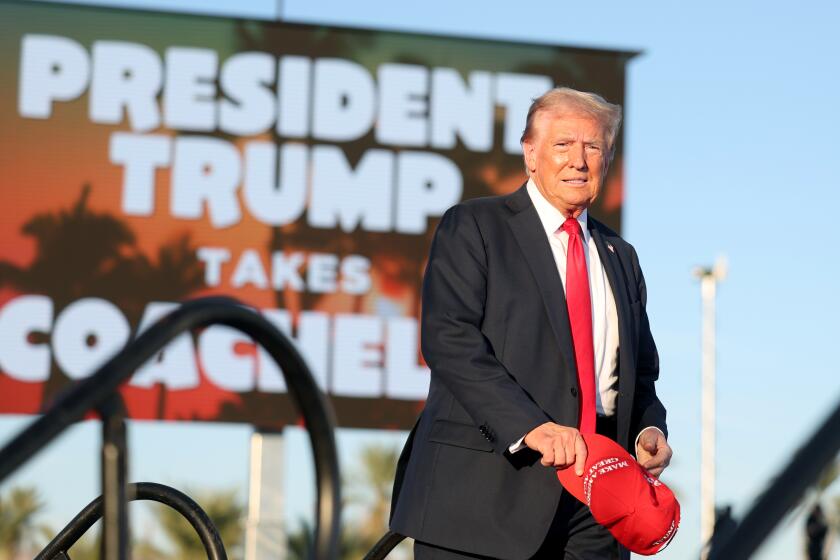State Gets Go-Ahead in B of A Settlement : Final Barrier to Paying Former Depositors Is Apparently Lifted
SACRAMENTO — A Superior Court judge Wednesday gave state Controller Gray Davis permission to start the enormous task of “reuniting” Bank of America depositors with $47 million in cash the bank took from their dormant accounts.
The action of Judge A. Richard Backus appeared to knock down the final barrier to resolution of the contentious 13-year-long fight between the state controller’s office and the bank.
Specifically, the judge approved a $1-million public relations campaign aimed at getting the word out to Bank of America depositors that they may be eligible to reclaim funds that were illegally kept by the bank.
Additional Funds for Program
The judge also agreed to add another $995,000 to the $3.1 million previously authorized for the “reunification” program to hire 13 more temporary controller employees and to obtain 20 more toll-free telephone lines.
The program is financed from interest paid from settlements previously reached between the bank and state.
“This is the biggest reunification project that we have ever undertaken and probably the biggest one in the United States,” said D. Robert Shuman, chief counsel to Davis.
Armed with a public relations company, special computers, a beefed-up staff of temporary employees and toll-free telephone lines, Davis must seek out perhaps millions of people whose inactive accounts were turned over to him under the state’s unclaimed property law and try to return the money to them or their heirs.
In some cases, the bank wiped out with service charges accounts that had been inactive for seven years and failed to credit the accounts with interest. In other cases, the bank turned over the remains of accounts after first extracting service charges.
The accounts usually became inactive because their holders forgot about them, moved away or died.
Cory Filed Suit
In 1975, then-state Controller Ken Cory charged in a lawsuit that Bank of America and other banks had no legal right to levy service charges on dormant accounts or to fail to credit the accounts with interest. In 1980, Judge Backus ruled in his favor in the Bank of America case.
Cory sued other banks, as well. However, they agreed to settlements rather than go to trial. Bank of America was the only financial institution to fight it out in court.
Levying service charges on inactive accounts has been outlawed since 1976 unless banks and other financial institutions give customers clear warning in advance.
Under the 1959 unclaimed property law, financial institutions must search for customers whose accounts have been dormant for seven years. If they cannot locate them, the contents are turned over to the controller, who also must make a search.
In theory, the funds are held in perpetuity for the account holders. But in practice, the unclaimed money flows into the state general fund for government operations.
Affected by the “outreach” program will be Bank of America customers whose accounts became dormant from 1949 to 1983, although the bank destroyed many of the records of names and addresses when the accounts became extinct. The precise number of customers entitled to their money is uncertain.
Consequently, the responsibility for uniting depositors with their money will be up to Davis’ “outreach” program and to bank customers themselves who believe they are eligible for reimbursement. During the past few years the controller’s office has averaged a return rate of 26.5% on all unclaimed property.
Backus has ordered the controller’s office to develop an aggressive “outreach” effort, including the hiring of the Los Angeles public relations firm of Rogers and Associates to publicize the operation.
Advertising Campaign
To get the word out to bank customers, Shuman of the controller’s office said the campaign will involve paid television advertising, radio and television public service spots, talk shows and press conferences.
If the controller has a name and address of a depositor who appears to be in line for some money, a notice will be sent to the person’s last known address in the hope that contact can be made, Shuman said.
But for customers whose bank records were destroyed when their accounts were wiped out, Shuman said, the controller must rely on the depositors’ own records, such as a passbook, to determine whether they are eligible for a portion of the settlement.
“The best way to reach these people, who we don’t know who they are, is through the advertising program,” he said.
More to Read
Get the L.A. Times Politics newsletter
Deeply reported insights into legislation, politics and policy from Sacramento, Washington and beyond. In your inbox three times per week.
You may occasionally receive promotional content from the Los Angeles Times.










